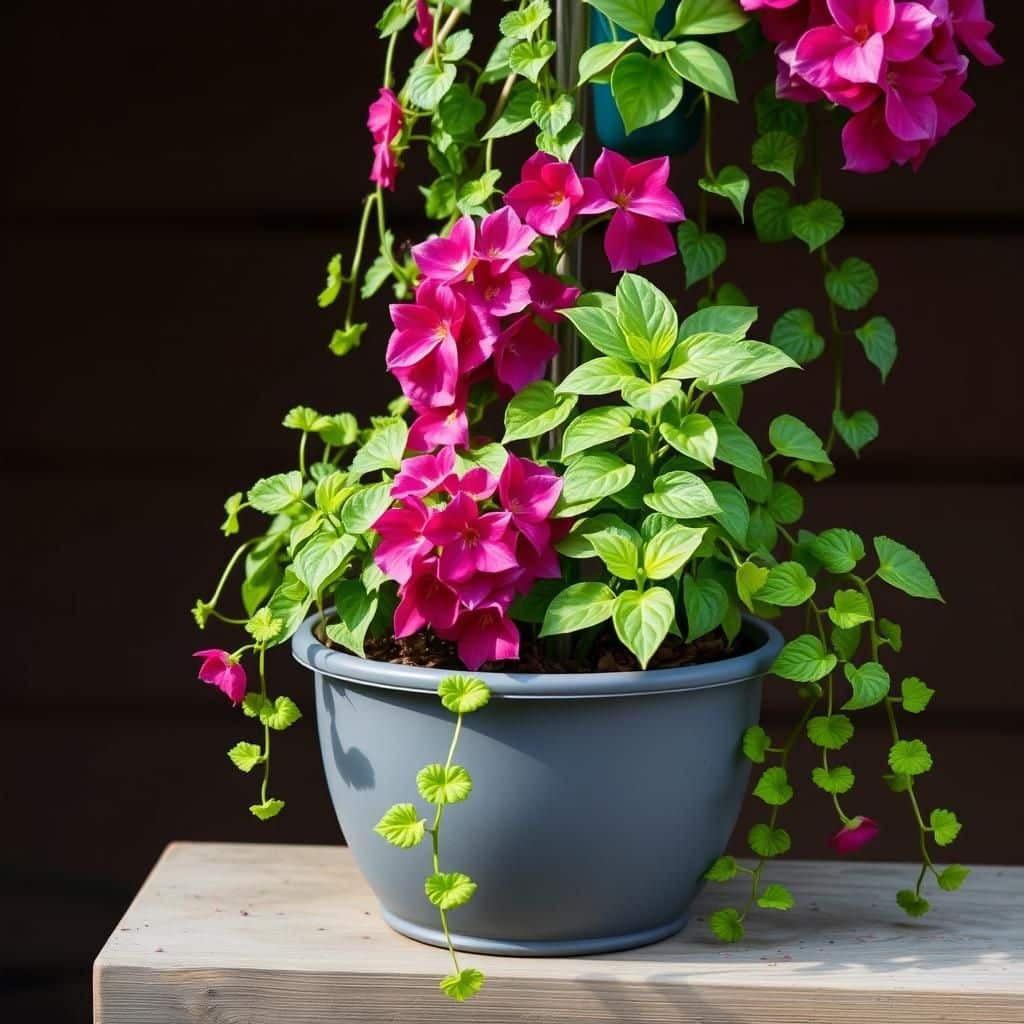The Ultimate Guide to Growing Climbers in Containers for Stunning Vertical Gardens

Creating a stunning vertical garden can transform any outdoor or indoor space, and growing climbers in containers is an excellent way to achieve this. Whether you're working with limited space or want to add dimension and beauty to your garden, container gardening with climbers offers versatility and flair. This ultimate guide will delve into the best climbers for container growth, essential care tips, and innovative ideas to maximize your vertical gardening potential. From fragrant blooms to lush greenery, you'll discover how to harness the power of climbers to enhance your environment and create a breathtaking vertical sanctuary.
Growing Climbers in Containers: A Guide to Success
Growing climbers in containers can be a rewarding endeavor, allowing you to enjoy vertical gardening even in limited spaces. Containers provide flexibility, enabling you to customize your growing environment according to the needs of the specific plants you choose. For successful cultivation, select the appropriate size container to ensure adequate root growth and drainage. Utilizing a high-quality potting mix enriched with nutrients will promote healthy growth and flowering. Additionally, consider the amount of sunlight, water, and support structures you will need to provide for different climber species.
Choosing the Right Container Size
When it comes to growing climbers in containers, selecting the right container size is crucial for optimal plant health. Larger containers can hold more soil, which retains moisture and nutrients necessary for robust root development. Generally, choose a container that is at least 12 inches deep, but larger climbers may require even bigger pots to accommodate their extensive root systems. Drainage holes are essential to prevent waterlogging, so ensure your container has adequate drainage to keep the roots healthy.
Soil and Nutrient Requirements
The quality of soil plays a pivotal role in the success of growing climbers in containers. Use a well-draining potting mix that includes organic materials to retain moisture without becoming overly compacted. Additionally, it is advisable to incorporate slow-release fertilizers that provide essential nutrients over time. Regularly monitoring the nutrient levels and adjusting with liquid fertilizers during the growing season will ensure your climbing plants receive adequate nourishment for vigorous growth.
Watering Techniques
Proper watering techniques are vital to maintaining climbers in containers. Over-watering can lead to root rot, while under-watering may stress the plants. A general rule of thumb is to check the soil moisture regularly; if the top inch of soil feels dry, it is time to water. Ensure that water drains out of the bottom of the container to encourage healthy root growth and prevent water accumulation. Factors such as container material, climate, and plant type will influence the frequency of watering, so observe your plants closely for signs of stress.
See also:
Supporting Your Climbers
Support structures are essential for climbing plants to thrive in containers. Providing a sturdy trellis, stakes, or cages allows climbers to grow upward, maximizing light exposure and air circulation. As the plants grow, guide their stems gently towards these supports to encourage healthy growth patterns. Regularly check the integrity of your support system and adjust as needed to prevent breakage or damage to the plants. The right support will also enhance the aesthetic appeal of your container garden.
Choosing Suitable Climber Varieties
Selecting the appropriate climber varieties for container growth is essential for success. Some plants are better suited for container gardening due to their root system characteristics and growth habits. Ideal choices for containers include varieties like sweet peas, morning glories, and climbing nasturtiums, which tend to thrive in limited space. Consider the local climate, sunlight conditions, and available space when picking climbers, as these factors will influence their growth and overall health in a confined environment.
| Aspect | Recommendation |
|---|---|
| Container Size | At least 12 inches deep, larger for extensive root systems |
| Soil Type | Well-draining potting mix with organic materials |
| Watering Frequency | Once the top inch of soil feels dry |
| Support Structure | Trellis, stakes, or cages for climbing |
| Variety Selection | Sweet peas, morning glories, climbing nasturtiums |
Essential Tips for Selecting the Right Climate for Your Climbing Plants
Choosing the right climate for your climbing plants is crucial when growing them in containers for vertical gardens. Different species have specific requirements regarding temperature, humidity, and sunlight exposure. Ideally, assess your environment to determine whether it aligns with the needs of your plants, as factors such as local weather patterns and seasonal changes can significantly influence their growth. For instance, some climbing plants thrive in warm, sunny spots, while others prefer cooler, shadier areas. Therefore, understanding the unique characteristics of your selected climbing plants will guide you to create the perfect environment that promotes lush growth and vibrant blooms.
Choosing the Right Containers for Climbing Plants
Selecting the appropriate containers is vital for the success of your climbing plants. The size, material, and drainage capabilities of the pot can significantly impact plant health. It is essential to choose containers that are large enough to accommodate root growth while ensuring they provide adequate drainage to prevent overwatering. Materials such as terra cotta or ceramics are popular, but lightweight options like plastic or fabric pots may also be beneficial for easier mobility and better moisture retention. Ultimately, the right container will support healthy root development and sustain the growth of vigorous climbing plants.
Best Climbing Plants for Container Gardening
When it comes to container gardening, selecting the right climbing plants is critical for achieving a stunning vertical garden. Popular options include clematis, which offers a range of colors and sizes, and honeysuckle, known for its fragrant blooms. Other excellent choices are sweet peas, which provide a delightful scent and vibrant hues, and morning glories, celebrated for their quick growth and colorful flowers. Ensure that the selected plants are compatible with your climate and the growth conditions of your garden to ensure a flourishing display.
See also:
Support Structures for Climbing Plants
Creating suitable support structures is essential for climbing plants to flourish in containers. Options range from traditional trellises to more creative solutions like fencing or lattice work. The chosen support should be durable and anchored securely in the container. Providing ample support not only helps the plants grow upward, enhancing their exposure to sunlight, but also encourages aeration and circulation around the leaves, promoting overall plant health. Moreover, consider the aesthetics of the support mechanism; it should complement your garden's design while being functional.
Watering and Nutritional Needs of Container Climbing Plants
The watering and nutritional demands of climbing plants in containers can differ significantly from those in ground gardens. Container-grown plants may require more frequent watering due to the limited soil volume which can dry out quickly. It's essential to establish a consistent watering schedule that aligns with the needs of your chosen species, observing soil moisture levels to prevent both overwatering and drought stress. Additionally, implementing a regular fertilization routine is important to replenish nutrients, particularly during the growing season, ensuring that your climbing plants remain healthy and vibrant.
Pruning Techniques for Healthy Growth
Pruning is a critical aspect of maintaining healthy growth in climbing plants. Proper pruning techniques can promote stronger flowering and improve air circulation, reducing the risk of disease. It's essential to understand the specific pruning needs of each climbing variety, as some benefit from light pruning throughout the season, while others may require more extensive cuts during their dormant period. Regularly removing dead or damaged growth will encourage the plant to divert its energy toward new growth and blooms, fostering an overall more robust and attractive vertical garden.
Questions from Our Readers
What types of climbers are suitable for container growing?
When choosing climbers for container growing, it's essential to select varieties that thrive in limited root space. Popular options include sweet peas, cucumbers, and climbing beans, which not only grow well in pots but also provide vertical interest and fruit or flowers in smaller gardens.
How do I care for climbing plants in containers?
Caring for climbing plants in containers involves ensuring they receive adequate water, nutrients, and support. Make sure to use well-draining potting mix, water regularly but avoid waterlogging, and provide a suitable trellis or support structure to promote healthy upward growth.
See also:
Can climbing plants survive winter in containers?
Yes, many climbing plants can survive winter in containers, but they may require some protection depending on your climate. Insulating the container with bubble wrap or relocating it to a more sheltered area can help protect the roots from freezing temperatures, ensuring that the plant remains healthy until the next growing season.
What size container is best for growing climbers?
The best container size for growing climbers depends on the plant's root system, but a minimum of 5 gallons is usually recommended for most climbing species. Larger containers provide more soil volume, allowing for better moisture retention and nutrient availability, which ultimately supports a more robust and healthy plant.

If you want to read more articles like The Ultimate Guide to Growing Climbers in Containers for Stunning Vertical Gardens, we recommend you check out our Planter category.
Leave a Reply
Related Articles